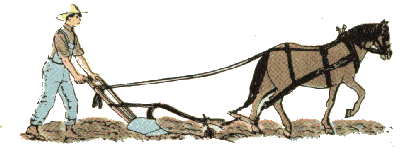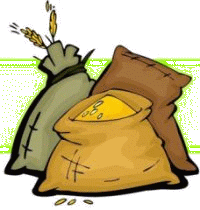EARLY DAYS

PIONEER TOOLS
PLANTING AND HARVESTING




- The axe was a very important tool. With an axe the homesteader built a home, chopped firewood, chopped down trees and cleared the land.
- A pickaxe, hoe and spade (shovel) were used for digging and turning over the soil.
- A wooden rake was used to level the soil.
- Grain or hay was cut with a scythe (a long blade on a stick) or a sickle (a curved blade on a stick) and left to dry in the sun.
- A cradle scythe (also called a hand cradle) cut the hay and also dropped the hay in piles.
- A pitchfork was used to gather up the hay or grain into piles. Then the hay or grain was loaded onto a cart or wagon and stored in the barn.
- A flail was used to separate the seeds from the rest of the plant.


plowing (ploughing) to prepare for planting
The land was broken up with a plow (or plough). The plow had a sharp blade that cut into the earth and turned over the soil. The plow was pulled by oxen or horses. The farmer kept the blade of the plow in the ground and had to be careful not to hit any large rocks, stumps or roots. Next a harrow was pulled over the soil to break up the lumps and smooth out the ground. A harrow looked like a large rake with rows of teeth.
a harrow broke up the lumps of earthThen the farmer sowed the seed (planted). Wheat, rye, oats, barley and flax (for making linen) were planted. After the seeds were planted, there were many ways that the crop could fail. Too many weeds, drought (no rain), floods, frost, hail, insects, plant diseases and prairie fires destroyed crops.

HARVESTING AND THRESHING
a scythe was used for harvesting
When a crop was ready to harvest the farmer used a sickle, scythe or cradle scythe to cut the crop. Then the stalks were bundled into sheaves. The bunch of sheaves were leaned against each other so the sheaves stood up. The standing bundles were called stooks .The stooks were left to dry in the field. Later, the sheaves were hauled to the barn.
a flail was used to pound out the seed grainThe grain was spread out on the floor of the barn or outside on the ground and hit with a flail. Seeds, chaff (bits of seed head) and straw remained. The straw was used as bedding for the farm animals or as mattress-filler.
The grain seeds and chaff were placed in a winnowing tray (or basket) and shaken and tossed on a windy day. The wind blew the light straw and chaff away and the seed would fall back in the tray.

Winnowed grain was stored for animal feed or taken in sacks to the mill to be ground into flour. Stone-ground flour was better than flour ground by hand.
Grain was saved to plant next year. Grain was also soaked and cooked to make a type of porridge. If there was enough grain it was sold or traded for supplies.

